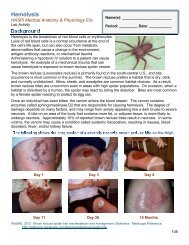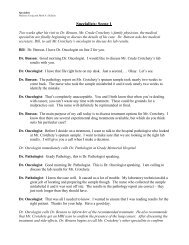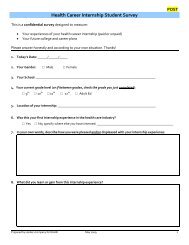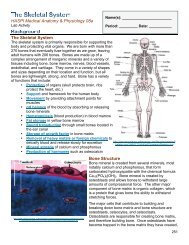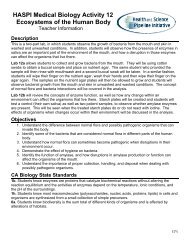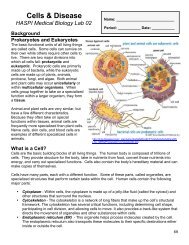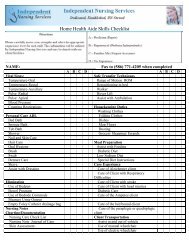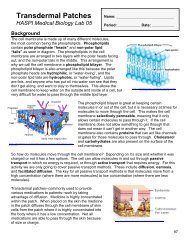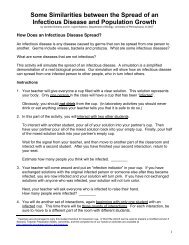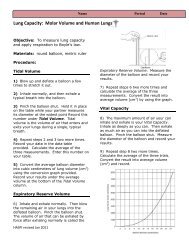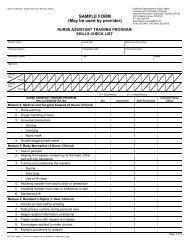HASPI Medical Biology Lab 03 Cellular Respiration & Exercise
HASPI Medical Biology Lab 03 Cellular Respiration & Exercise
HASPI Medical Biology Lab 03 Cellular Respiration & Exercise
- No tags were found...
You also want an ePaper? Increase the reach of your titles
YUMPU automatically turns print PDFs into web optimized ePapers that Google loves.
<strong>HASPI</strong> <strong>Medical</strong> <strong>Biology</strong> <strong>Lab</strong> <strong>03</strong><strong>Cellular</strong> <strong>Respiration</strong> & <strong>Exercise</strong>Teacher InformationDescriptionStudents will have the opportunity to observe the effects of exercise on cellular respiration rates.Increased exercise means increased cellular respiration, which produces more carbon dioxide as aby-product that will be released by the lungs. A comparison between carbon dioxide productionwhile resting, during anaerobic exercise, and during aerobic exercise will be made. A review of thecellular respiration process and short-term/long-term health effects of consistent exercise will beavailable in the analysis.Objectives1. Understand the relationship between oxygen and carbon dioxide in relation to cellularrespiration.2. Identify the reactants and products of cellular respiration and photosynthesis.3. Demonstrate the effects of exercise on carbon dioxide production, and relate the amount ofcarbon dioxide production to the cellular respiration process.4. Demonstrate the difference in resting, aerobic, and anaerobic exercise on carbon dioxideproduction.5. Identify short and long term health effects of consistent exercise.CA State Standards1f. Students know usable energy is captured from sunlight by chloroplasts and is stored through thesynthesis of sugar from carbon dioxide.1g. Students know the role of the mitochondria in making stored chemical-bond energy available tocells by completing the breakdown of glucose to carbon dioxide.1i.*Students know how chemi-osmotic gradients in the mitochondria and chloroplast store energy forATP production.9a. Students know how the complementary activity of major body systems provides cells with oxygenand nutrients and removes toxic waste products such as carbon dioxide.Time: 40-50 minutesThe 50 ml bottle of phenolphthalein will need to be added to 1000 ml of water. The students will pourabout 100 ml of this phenolphthalein solution into their flasks. They will also pour 5 ml of the sodiumhydroxide solution into their small beakers. The lab itself will require approximately 25-30 minutes.Analysis may take a bit longer, and you may consider having the students do additional tests withexercises that they create. Analysis will take about 15-20 minutes, but can be completed ashomework.79
Materials Supplies needed for 10 lab groupsSupplyQuantityProvided (P) orNeeded (N)Phenolphthalein solution P 50 ml.04% Sodium hydroxide solution P 100 mlStraws P 40Plastic pipettes P 20Small beakers – for sodium hydroxide solutions N 10Flasks (200-500 ml) N 20Graduated cylinder (100 ml) N 10Stoppers N 10IMPORTANT: Check the MSDS for safety information on unfamiliar chemicalsAdditional InformationBoth phenolphthalein and sodium hydroxide are clear, so make sure the students do notconfuse them.The stopper is necessary to reduce the amount of carbon dioxide that diffuses out of the flask.This is a great opportunity to discuss experimental error.Kit Replenishment Instructions- <strong>HASPI</strong> Supported Sites OnlyFunds permitting, <strong>HASPI</strong> will replace annually: Straws Phenolphthalein solution (MUST return bottle for refill) Sodium hydroxide solution (MUST return bottle for refill)Not being replaced annually, please recycle and reuse: Plastic pipettesResources and ReferencesAdapted from Carbon Dioxide Production <strong>Lab</strong> by Joel Vexler, Valley Center High School,2011.Waldron, I. and Doherty, J. 2005. Breathing and Holding Your Breath. Department of<strong>Biology</strong>, University of Pennsylvania. http://serendip.brynmawr.edu/sci_edu/waldron/Heather Peterson, <strong>HASPI</strong> Curriculum Coordinator. www.haspi.orgEdited by Janet Hoff-Kneier, <strong>HASPI</strong> Program Manager. www.haspi.orgImages (in order of appearance) http://kentsimmons.uwinnipeg.ca/cm1504/Image150.gif http://getbodyshape.com/wp-content/uploads/2011/07/runner1.jpg http://www.musclegaintruth.us/wp-content/uploads/2011/01/weight-lifting-exercises.jpg www.clevelandclinic.org/health/<strong>HASPI</strong> <strong>Medical</strong> <strong>Biology</strong> <strong>Lab</strong> <strong>03</strong>, <strong>Cellular</strong> <strong>Respiration</strong> & <strong>Exercise</strong>, Teacher Info; Revised July 2011 80



